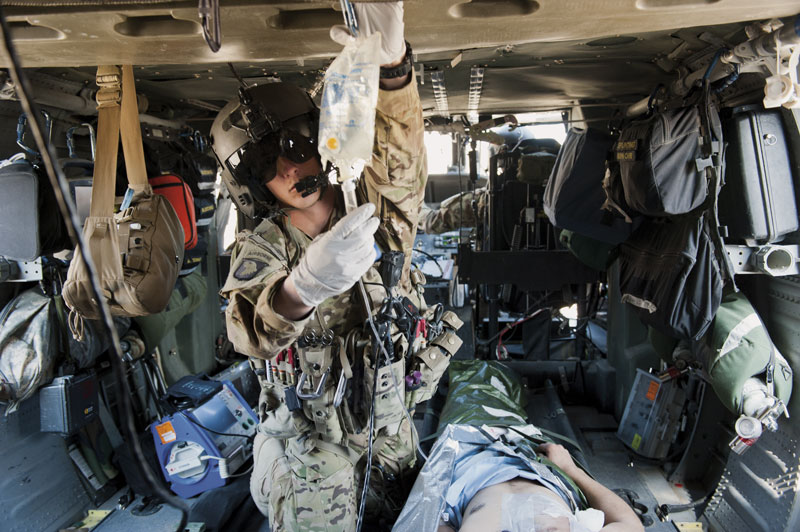
Photo courtesy of the U.S. Army. Photo by Sgt. Duncan Brennan, 101st Combat Aviation Brigade public affairs.
Getting wounded soldiers the fastest, most skilled emergency medical care possible and transporting them to forward units or hospitals has long been a priority in warfare. To that end, the Army turned to the Long School of Medicine and its expertise in emergency care.
After a yearlong pilot project in 2011, the Department of Emergency Health Sciences was selected by the Army in 2012 to train all Army flight medics. A five-year contract calls for the university to provide four paramedic certification courses and four critical care transport courses per year for flight medics. This year, due to the success of the program, the department will offer six courses.
It’s a charge that Lance Villers, Ph.D., LP, associate professor and chair of the department, doesn’t take lightly.
“All of these soldiers are EMTs who were trained at Fort Sam,” Dr. Villers said, explaining that San Antonio’s Fort Sam Houston is the center for all medical training for the Army. “Many of them have been deployed and have combat experience. Then all of the designated flight medics for the Army are brought back here for our training.”
Intensive classroom instruction covers anatomy/physiology, patient assessment, advanced airway procedures, cardiovascular emergencies, medical and trauma emergencies, EMS operations, hospital clinicals and EMS field practicums.
“When they finish our program, they’re prepared for national certification for paramedic,” Dr. Villers said. And then immediately “they start an eight-week, critical care transport program. This is even more advanced training that prepares them for a national certifying program to be flight paramedics.”
Rotations include the operating room for airway procedures, various intensive/critical care wards, the burn unit, cardiac catheterization lab, neonatal intensive care unit and pediatric intensive care unit, and obstetrics for delivering babies. This phase emphasizes the development of critical thinking skills.
All clinical time is done at civilian hospitals and specialty clinics in the San Antonio area.
Lt. Col. Neil B. Davids, M.D., LTC, Critical Care Flight Paramedic Program director at Fort Sam Houston, said the program’s quality is reflected in its high first-time pass rate on the National Registry Paramedic certification exam—nearly 20 percent higher than the national average.
“Getting the clinical experience, both in the hospital and riding out with various EMS agencies, has been crucial in meeting our goal of having paramedics with critical care training [available] to the fighting force,” he said.
Dr. Villers finds significance in the work his department does for the Army.
“This training makes a difference for soldiers,” he said. “Once these soldiers complete our training, they go right back out to their deployments, many to a combat zone. And they’ve been given a new set of tools, of knowledge, to save people’s lives. We’re proud to be part of that.”
